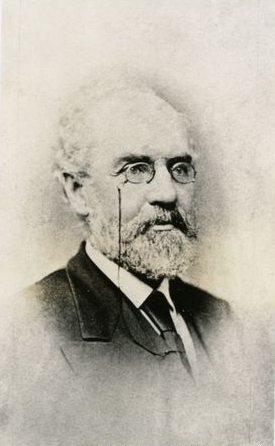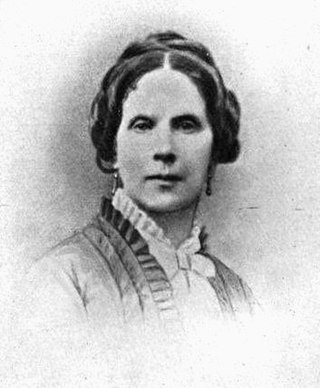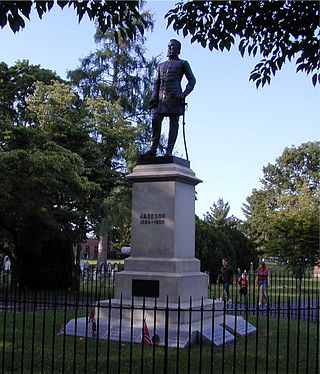
Thomas Jonathan "Stonewall" Jackson was a general officer in the Confederate States Army during the American Civil War. He played a prominent role in nearly all military engagements in the Eastern theater of the war until his death. Military historians regard him as one of the most gifted tactical commanders in U.S. history.

Lexington is an independent city in Shenandoah Valley of Virginia, United States. At the 2020 census, the population was 7,320. It is the county seat of Rockbridge County, although the two are separate jurisdictions, and is combined with it for statistical purposes by the Bureau of Economic Analysis. Lexington is about 57 miles (92 km) east of the West Virginia border and is about 50 miles (80 km) north of Roanoke, Virginia. First settled in 1778, Lexington is best known as the home of the Virginia Military Institute and Washington and Lee University.

The Virginia Military Institute (VMI) is a public senior military college in Lexington, Virginia. It was founded in 1839 as America's first state military college and is the oldest public senior military college in the United States. In keeping with its founding principles and unlike any other senior military college in the United States, VMI enrolls cadets only and awards bachelor's degrees exclusively. The institute grants degrees in 14 disciplines in engineering, science, and the liberal arts.

James Murray Mason was an American lawyer, politician, and Confederate statesman. He served as senator from Virginia, having previously represented Frederick County, Virginia, in the Virginia House of Delegates.

John Randolph Tucker was an American lawyer, author, and politician from Virginia. From a distinguished family, he was elected Virginia's attorney general in 1857 and after re-election served during the American Civil War. After a pardon and Congressional Reconstruction, Tucker was elected as U.S. Congressman (1875-1887), and later served as the first dean of the Washington and Lee University Law School.
Robert Latané Montague was a prominent Virginia lawyer, politician and judge, before and after the American Civil War. He twice won election to the Virginia House of Delegates, and also served during the Virginia Secession Convention of 1861, as Lieutenant Governor of Virginia, and in the Second Confederate Congress from. His son Andrew Jackson Montague became Governor of Virginia and a U.S. Congressman, and grandson Robert Latane Montague rose to become a general in the U.S. Marine Corps after receiving the Distinguished Service Cross in World War I.
Jeremiah Morton was a nineteenth-century politician, lawyer, physician and architect from Virginia. He was a younger brother of Florida senator Jackson Morton.

Alexander Robinson Boteler was a nineteenth-century planter turned businessman, as well as artist, writer, lawyer, Confederate officer, philanthropist and politician from Shepherdstown in what was initially Virginia and became West Virginia in the American Civil War.

Lexington was an 18th-century plantation on Mason's Neck in Fairfax County, Virginia, United States. The estate belonged to several generations of the Mason family, and is now part of Mason Neck State Park.

John James Davis was an American attorney and politician who helped found West Virginia and later served as a United States representative in Congress from that state.
Robert Murphy Mayo was a Virginia lawyer, Confederate officer and politician who served in the Virginia House of Delegates and briefly in the United States House of Representatives as a member of the Readjuster Party.

The Hermitage near Charles Town, West Virginia is historic property which includes several buildings, as well as non-contributing tennis courts and a pool. The oldest structure is a small stone cottage dating to circa 1734, making it one of the oldest buildings in West Virginia. It resembles Prato Rio in nearby Leetown, West Virginia and may date to this property's first owner, Daniel Barnett, who was a partner in the Burr Iron Works circa 1740, the first of its kind in the state. A stone privy is also believed to be the oldest structure of its kind in the state.

Margaret Junkin Preston was an American poet and author.

John Lawrence Marye Jr., was a Virginia lawyer, plantation owner, Confederate soldier and politician. He served in the Virginia House of Delegates during the American Civil War, and upon the legislature's election of Lt. Gov. John F. Lewis as one of Virginia's U.S. Senators following the Commonwealth's readmission to the Union, was elected the tenth Lieutenant Governor of Virginia (1870-1874) and as such presided over the Virginia Senate. Marye also represented Spotsylvania County in both the Virginia Secession Convention and the Virginia Constitutional Convention of 1868, when he was a leading opponent of Congressional Reconstruction.

The Oak Grove Cemetery, originally known as the Presbyterian Cemetery, is located on South Main Street in downtown Lexington, Virginia, less than a mile from the campuses of Washington and Lee University and the Virginia Military Institute. The cemetery was renamed in 1949 as the Stonewall Jackson Memorial Cemetery after the Confederate general, who was buried here in 1863. The current name dates to September 3, 2020. Also buried here are 144 Confederate veterans, two Governors of Virginia, and Margaret Junkin Preston, the "Poet Laureate of the Confederacy".

Providence Plantation and Farm, also known as Fogg House and Farm, is a historic plantation house located near Newtown in King and Queen County, Virginia. The two story, 3-bay Federal style brick main house was built about 1826, and expanded circa 1840. Also on the privately-held property, demonstrating the changes over time as the plantation which once encompassed about 1299 acres shrunk to the listed 6.47 acres, are the contributing two-story Reconstruction-era granary and carriage house, and Great Depression-era hen laying house, two-story sweet potato shed, and mechanic's shop.

John Thomas Lewis Preston was an American educator and military officer from Virginia. He was a primary founder and organizer of the Virginia Military Institute, and was one of its first two faculty members. He also served in the Confederate military during the American Civil War.
John A. Carter was a Virginia lawyer, farmer and politician, who represented Loudoun County, Virginia in both houses of the Virginia General Assembly for two terms each both before and after the American Civil War, as well as in the Virginia Constitutional Convention of 1850 and the Virginia Secession Convention of 1861.
Jacob Nicholas Liggett was a Virginia lawyer, Confederate officer, farmer and politician from Virginia.
Robert Edwin Cowan was a Virginia lawyer and politician who served in the Virginia House of Delegates and the Virginia Secession Convention of 1861 and as a Confederate officer. After the American Civil War, he moved to Kansas City, Missouri, where he resumed his legal practice and was elected a judge before his death and burial in St. Louis.


















